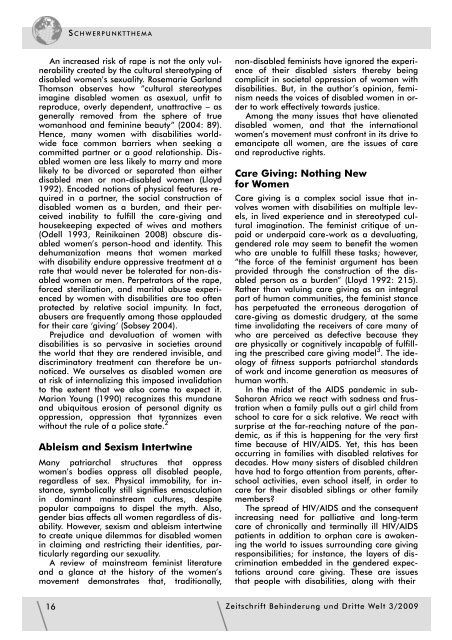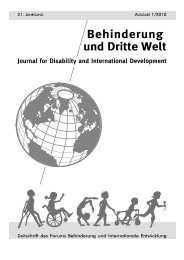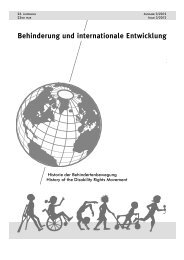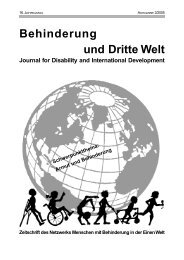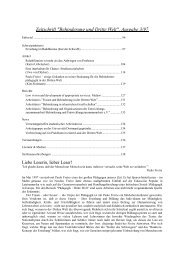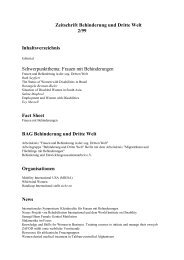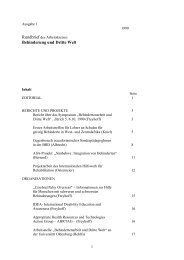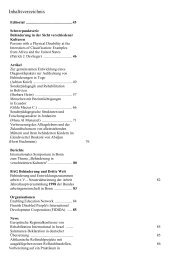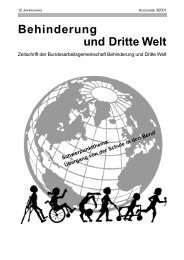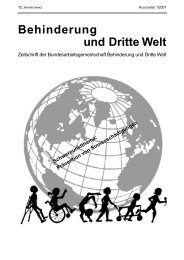Zeitschrift Behinderung und Dritte Welt
Zeitschrift Behinderung und Dritte Welt
Zeitschrift Behinderung und Dritte Welt
Create successful ePaper yourself
Turn your PDF publications into a flip-book with our unique Google optimized e-Paper software.
S CHWERPUNKTTHEMAAn increased risk of rape is not the only vulnerabilitycreated by the cultural stereotyping ofdisabled women’s sexuality. Rosemarie GarlandThomson observes how “cultural stereotypesimagine disabled women as asexual, unfit toreproduce, overly dependent, unattractive – asgenerally removed from the sphere of truewomanhood and feminine beauty” (2004: 89).Hence, many women with disabilities worldwideface common barriers when seeking acommitted partner or a good relationship. Disabledwomen are less likely to marry and morelikely to be divorced or separated than eitherdisabled men or non-disabled women (Lloyd1992). Encoded notions of physical features requiredin a partner, the social construction ofdisabled women as a burden, and their perceivedinability to fulfill the care-giving andhousekeeping expected of wives and mothers(Odell 1993, Reinikainen 2008) obscure disabledwomen’s person-hood and identity. Thisdehumanization means that women markedwith disability endure oppressive treatment at arate that would never be tolerated for non-disabledwomen or men. Perpetrators of the rape,forced sterilization, and marital abuse experiencedby women with disabilities are too oftenprotected by relative social impunity. In fact,abusers are frequently among those applaudedfor their care ‘giving‘ (Sobsey 2004).Prejudice and devaluation of women withdisabilities is so pervasive in societies aro<strong>und</strong>the world that they are rendered invisible, anddiscriminatory treatment can therefore be unnoticed.We ourselves as disabled women areat risk of internalizing this imposed invalidationto the extent that we also come to expect it.Marion Young (1990) recognizes this m<strong>und</strong>aneand ubiquitous erosion of personal dignity asoppression, oppression that tyrannizes evenwithout the rule of a police state. 2Ableism and Sexism IntertwineMany patriarchal structures that oppresswomen’s bodies oppress all disabled people,regardless of sex. Physical immobility, for instance,symbolically still signifies emasculationin dominant mainstream cultures, despitepopular campaigns to dispel the myth. Also,gender bias affects all women regardless of disability.However, sexism and ableism intertwineto create unique dilemmas for disabled womenin claiming and restricting their identities, particularlyregarding our sexuality.A review of mainstream feminist literatureand a glance at the history of the women’smovement demonstrates that, traditionally,non-disabled feminists have ignored the experienceof their disabled sisters thereby beingcomplicit in societal oppression of women withdisabilities. But, in the author’s opinion, feminismneeds the voices of disabled women in orderto work effectively towards justice.Among the many issues that have alienateddisabled women, and that the internationalwomen’s movement must confront in its drive toemancipate all women, are the issues of careand reproductive rights.Care Giving: Nothing Newfor WomenCare giving is a complex social issue that involveswomen with disabilities on multiple levels,in lived experience and in stereotyped culturalimagination. The feminist critique of unpaidor <strong>und</strong>erpaid care-work as a devaluating,gendered role may seem to benefit the womenwho are unable to fulfill these tasks; however,“the force of the feminist argument has beenprovided through the construction of the disabledperson as a burden” (Lloyd 1992: 215).Rather than valuing care giving as an integralpart of human communities, the feminist stancehas perpetuated the erroneous derogation ofcare-giving as domestic drudgery, at the sametime invalidating the receivers of care many ofwho are perceived as defective because theyare physically or cognitively incapable of fulfillingthe prescribed care giving model 3 . The ideologyof fitness supports patriarchal standardsof work and income generation as measures ofhuman worth.In the midst of the AIDS pandemic in sub-Saharan Africa we react with sadness and frustrationwhen a family pulls out a girl child fromschool to care for a sick relative. We react withsurprise at the far-reaching nature of the pandemic,as if this is happening for the very firsttime because of HIV/AIDS. Yet, this has beenoccurring in families with disabled relatives fordecades. How many sisters of disabled childrenhave had to forgo attention from parents, afterschoolactivities, even school itself, in order tocare for their disabled siblings or other familymembers?The spread of HIV/AIDS and the consequentincreasing need for palliative and long-termcare of chronically and terminally ill HIV/AIDSpatients in addition to orphan care is awakeningthe world to issues surro<strong>und</strong>ing care givingresponsibilities; for instance, the layers of discriminationembedded in the gendered expectationsaro<strong>und</strong> care giving. These are issuesthat people with disabilities, along with their16 <strong>Zeitschrift</strong> <strong>Behinderung</strong> <strong>und</strong> <strong>Dritte</strong> <strong>Welt</strong> 3/2009


